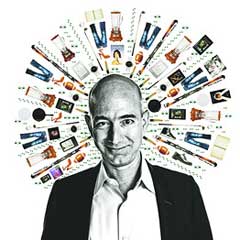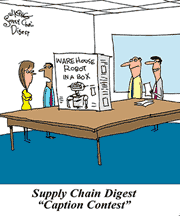Very Interesting Q1 Results for Amazon
I was at a conference for much of the week, and got a little behind, so I am going to take the somewhat easy way out and offer a look at some interesting recent developments at Amazon, the ecommerce giant which impacts most of us in both our business and personal lives.
Let's start to some extent at the end: Amazon's cratering stock price. As of end of day Thursday, Amazon was trading at about $2138 per share, down from $3719 as the all-time high seen on July 11 last summer, a drop of about $43%. It also means Amazon has given back almost all the incredible gains it saw from the start of the recession, when it dropped a little to $1785 in mid-March and then took off like a rocket.
| GILMORE SAYS: |
WHAT DO YOU SAY?'
Despite the decline in on-line sales, fulfillment costs – which do not include shipping – rose almost $4 billion to $20.2 billion.
Send us your
Feedback here
|
In January, Amazon stock fell to about $2879 from the July high, and many investment types were strongly recommending its shares as an opportunity to benefit from a temporary pull back. If you had heeded their advice, you would be down about 25% right now.
In fairness, Amazon's stock collapse is in part a reflection of a sharp overall market decline, especially a cratering of many technology-oriented, very “high multiple” stocks.
But part of it was also its own doing, based on its Q1 results reported late last week.
For the quarter, Amazon actually had a loss of about $3.8 billion. So much for its recent track record of decent profits. It had net income of $8.1 billion in Q1 2021. I will though note those results included a $7.6 billion write-down of its investment in electric vehicle manufacturer Rivian.
More interesting is the growth story. Amazon saw total revenue growth in the quarter of just 7% (9% if you eliminate changes in foreign exchange rates). Either number is obviously well down from the 20%+ regularly seen not long ago.
Still more interesting is that on-line sales actually fell 3% in Q1, after dropping 1% in Q4. While those declines came after very large gains year over year in Q1 2021 and Q4 2020, however you want to slice it ecommerce sales are - for now - flatlining at Amazon. As I asked a few weeks ago, could it be we are seeing a maturing, if you will, of the ecommerce marketplace already? (See Ecommerce is Eating the World a Lot more Slowly.)
 Amazon also forecast revenue in Q2 of between $116 billion and $121 billion, or to grow between 3% and 7% compared with second quarter 2021. Amazon also forecast revenue in Q2 of between $116 billion and $121 billion, or to grow between 3% and 7% compared with second quarter 2021.
But again, that's with most if not all of the growth coming from areas such areas as its AWS web services unit, third party marketplace commissions, and vendor advertising on Amazon.com.
AWS saw net sales grow almost 37% year over year from $13.5 billion to $18.4 billion. Its operating income increased 57% from $4.2 billion to $6.5 billion. Total Amazon operating income decreased to $3.7 billion in the first quarter, meaning everything together outside of AWS had negative operating income. The North American operation outside of AWS had about $1.5 billion negative operating income in the quarter, about the same as international.
Despite the decline in on-line sales, fulfillment costs - which do not include shipping - rose almost $4 billion to $20.2 billion. That equals an incredible 39% of the $51.1 billion in total on-line sales in the quarter. It is not clear in the earnings report data, but I assume some of that fulfillment expense is paid for by Amazon's Fulfilled by Amazon 3PL business for some of its marketplace sellers.
Still, the operating and depreciation costs of the huge number of various logistics sites (fulfilment centers, sortation centers, etc.) take a huge financial toll.
Shipping costs were another $19 billion, up 14% versus 2021 - again with on-line sales down 3% in the quarter. But again, some of this cost is surely paid for by FBA customers, and for shipping costs by Amazon Prime membership fee. Amazon used to report net shipping expense (costs minus Prime or other customer paid shipping revenue), but it no longer does.
Nevertheless, between fulfillment and sortation costs, you have to wonder how Amazon can ever make much of a profit.
And how is this for a twist: In the earnings call with the Wall Street analysts, Amazon CFO Brian Olsavsky said Amazon now has too many logistics workers.
Olsavsky said that it hired too quickly in its fulfillment centers during the pandemic in an effort to keep up with soaring demand for hand sanitizer and masks, and to have back-up workers for others that caught the omicron COVID variant.
But now sales of masks and other protective gear is slowing, while COVID cases have been way down. Add to that, Amazon recent decline in overall on-line sales, and voila, excess fulfillment workers.
Amazon hired 270,000 new workers just in the second half of 2021.
The company will not have to lay off any FC workers to get back in balance, according to spokeswoman Kelly Nantel. That's because turnover remains very high, as much as 100% or more at some facilities, so attrition should take care of the problem quickly.
So there you have it - Amazon's interesting Q1. Will we ever see 20% type on-line sales growth from the company again? I think No, as the law of large numbers has finally taken hold - and maybe the balance of on-line and physical store sales stabilized quite a bit, contrary to my previous thinking.
What do you think of Amazon's Q1? Let us know your thoughts at the Feedback button (email) or section below.
|








 Amazon also forecast revenue in Q2 of between $116 billion and $121 billion, or to grow between 3% and 7% compared with second quarter 2021.
Amazon also forecast revenue in Q2 of between $116 billion and $121 billion, or to grow between 3% and 7% compared with second quarter 2021.


